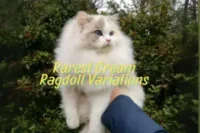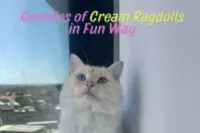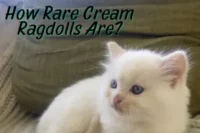Lilac Ragdoll Cat: Exploring Color, Genetics & Value of Lilac Point Ragdolls With Real Pictures
Published: 8 Sep 2025
I believe you definitely saw a Lilac Ragdoll Cat, but don’t know the exact appearance. With their frosty white coats, soft lilac points and those dreamy blue eyes, they almost feel like little fairytale companions. We have raised and cared for Ragdolls in different shades but the lilac always steals our hearts with its pastel charm. 💜🐾
In this post, we are going to share everything we have learned about this rare and beautiful color variation from what makes a Lilac Ragdoll unique to how their coat changes as kittens grow and even a few fun myths and facts along the way.
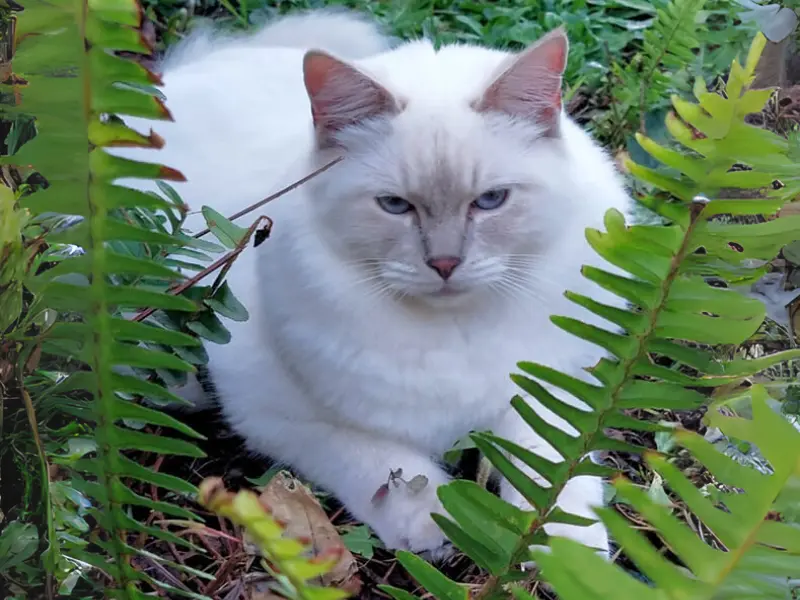
What is a Lilac Ragdoll Cat?
A Lilac Ragdoll Cat is not actually purple, though we know the name might make you imagine a fluffy lavender kitty! The term lilac in cat colors is used to describe a very soft, diluted version of chocolate. It looks like a pale, pinkish-gray tone that shows up beautifully on a Ragdoll’s silky fur.
These gentle shades appear on the “points” of the cat like the ears, face mask, paws and tail while the rest of their body stays a frosty white or magnolia cream. Add in those famous Ragdoll blue eyes and you have got a kitty that looks like they stepped right out of a storybook.
What makes the Lilac Ragdoll extra special is just how rare this color is. Unlike seal point or blue Ragdolls which are more common, the lilac shade only appears when the right genes come together. That’s why meeting a Lilac Ragdoll in person often feels like meeting a unicorn in the cat world.
The Appearance of a Lilac Ragdoll Cat
When we first meet a Lilac Ragdoll, the very first thing that catches our eye is their dreamy coloring. Unlike darker Ragdoll shades, the lilac coat feels almost magical. It was soft, subtle and full of charm.
Coat Colors and Points
- Points (ears, face, paws and tail) are a pale pinkish-gray shade with a soft lavender tint.
- Body color is usually creamy white or magnolia, giving a beautiful frosty contrast.
- The coat looks silky and plush with that signature Ragdoll fluff that begs for cuddles.
Eyes That Steal Hearts
Like all Ragdolls, lilacs have those stunning blue eyes that seem to sparkle when the light hits just right. The contrast between the pale coat and the bright eyes makes their gaze feel even more enchanting.
Overall Look
Lilac Ragdolls have a soft, powdery beauty compared to other shades. Their lighter tones give them a delicate and angelic look, almost as if they have been dusted with fairy dust. Whenever we watch our lilac Ragdoll lounging in the sun, we can’t help but admire how their fur glows and changes with the light. It’s one of those little joys that makes living with them extra special.
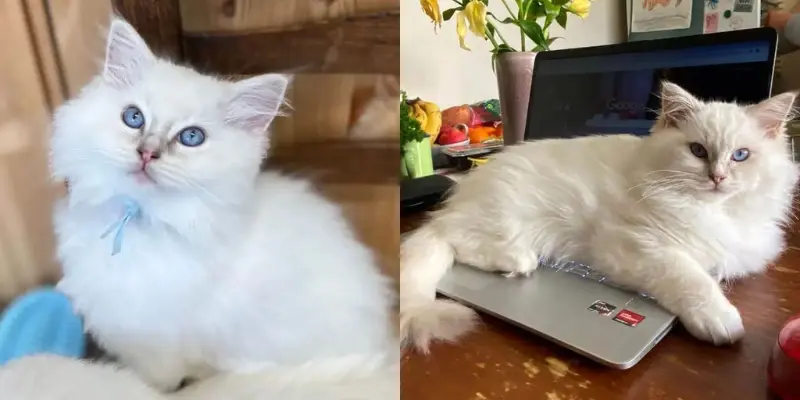
Which Parents Can Make a Lilac Point Ragdoll?
One of the questions we often hear from curious cat lovers is: how do breeders create such a rare color like lilac? The answer lies in cat genetics but don’t worry, we will keep it simple.
The Secret Behind the Lilac Shade
- The lilac color is actually a diluted version of chocolate.
- For a kitten to be lilac, both parents must carry the chocolate gene and the dilution gene.
- This careful mix turns what would normally be a deep chocolate shade into that dreamy pastel lilac we adore.
Parent Combinations
- Two lilac parents will always produce lilac kittens.
- Chocolate + Lilac parents can also result in lilac kittens, depending on which genes the babies inherit.
- Blue or seal parents can only create lilac kittens if they both carry the hidden chocolate and dilution genes.
Why This Makes Them Rare
Because the lilac shade depends on such a specific gene pairing, not every Ragdoll litter will have them. That’s why seeing a lilac kitten feels extra magical, it’s a little like winning the kitty lottery! When our first lilac kitten started showing her colors, we couldn’t believe how soft and delicate her fur looked compared to her littermates. It truly felt like we had a one-of-a-kind treasure.
Lilac Ragdoll Color Changes from Kitten to Adult
When lilac Ragdoll kittens first arrive in the world, they are tiny bundles of pure white fluff. At this stage, it’s almost impossible to tell what color they will grow into and it’s like a little mystery hidden in their genes.
From Snowy Newborn to Pastel Beauty
- Newborn stage: Lilac kittens are born completely white.
- Weeks 2–4: You may start to see the faintest shading on their ears and nose.
- Around 8–12 weeks: Their lilac “points” (ears, face, paws and tail) begin to show more clearly.
- 6–12 months: The lilac tones deepen slightly but still stay soft and powdery compared to darker colors.
- 2–3 years: The coat reaches full maturity, showing the true lilac color in all its pastel glory.
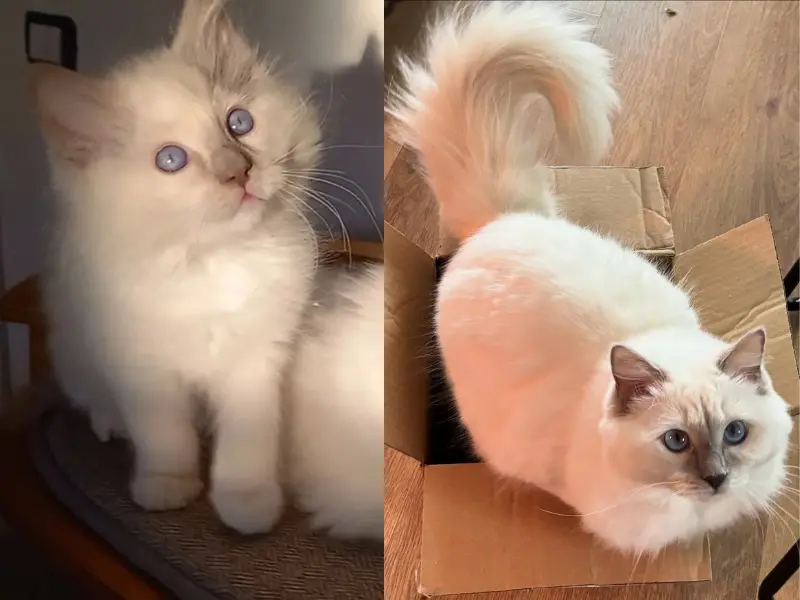
Why the Changes Happen
Ragdolls (and other pointed breeds) have a special gene called the temperature sensitive colorpoint gene. In simple words, it means their fur color develops more strongly on the cooler parts of their body like ears, nose, paws and tail. That’s why the “points” get darker as they grow while their bodies stay lighter.
Our Experience
We still remember the excitement of checking our lilac kitten every few weeks, eager to see how her colors were coming in. It felt like watching a watercolor painting slowly come to life which is delicate, soft and absolutely beautiful.
Rarity & Uniqueness of the Lilac Ragdoll
If you have ever met a Lilac Ragdoll in person, you will know right away that they are not something you see every day. Among all the Ragdoll colors, lilac is considered one of the rarest and that’s part of what makes them so special.
Why Lilac Ragdolls Are Rare
- Their color comes from a very specific genetic combination (chocolate + dilution).
- Not every breeding pair carries these genes, so lilac kittens don’t appear in every litter.
- Breeders often describe lilacs as “unicorns” in the Ragdoll world because of how uncommon they are.
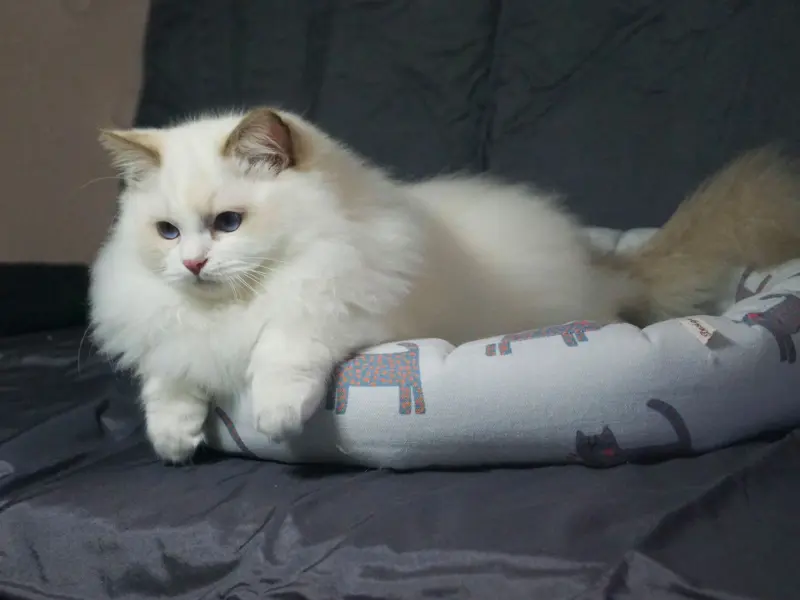
What Makes Them Stand Out
- Their soft pastel look makes them instantly different from the richer tones of seal, chocolate or even blue Ragdolls.
- Lilacs often look extra elegant because of the gentle contrast between their frosty white bodies and their pinkish gray points.
- Their rarity often makes them highly sought-after by cat lovers who dream of owning this fairytale shade.
A Treasure in the Cat World
Every time we cuddle our lilac fluffball, we feel like we are holding something truly unicorn. It’s not just their color but it’s the way their gentle appearance matches their famously sweet Ragdoll personality. Rare, yes but also full of love and charm.
Colour Comparisons of Lilac Point Ragdoll Cat
Lilac Ragdolls are sometimes tricky to identify, especially when they are kittens and their coats are still developing. Many new cat parents confuse them with blue or chocolate Ragdolls. To make things easier, let’s take a closer look at how lilac compares with the other main Ragdoll colors.
Lilac vs. Blue Ragdoll
At first glance, lilac and blue Ragdolls might look very similar. But when you place them side by side, the difference becomes clear.
- Lilac points: Soft, pale pinkish-gray with a lavender undertone that looks almost powdery.
- Blue points: A deeper steel gray with a cool, smoky tone.
- Key difference: Lilac is noticeably lighter and warmer while blue has a darker, cooler finish.
We like to say lilac looks like a frosted pastel, while blue feels more like a stormy gray sky.
Lilac vs. Chocolate Ragdoll
Because lilac is actually a diluted version of chocolate. It’s easy to confuse the two, especially in younger kittens.
- Lilac points: Light and muted, with a rosy gray tint.
- Chocolate points: Medium and warm brown with a true cocoa appearance.
- Key difference: Chocolate looks richer and deeper while lilac has a much softer, pastel glow. When we look at our chocolate and lilac side by side, the chocolate feels cozy like a mug of hot cocoa while the lilac feels airy and delicate, almost like cotton candy.
Lilac vs. Seal Ragdoll
Seal Ragdolls are the complete opposite of lilacs when it comes to color strength.
- Lilac points: Gentle, pale lavender gray.
- Seal points: Very dark, almost black brown.
- Key difference: Seal has a dramatic, high-contrast look while lilac is all about soft and subtle beauty.
When they are together, the seal looks bold and striking while the lilac looks dreamy and angelic.
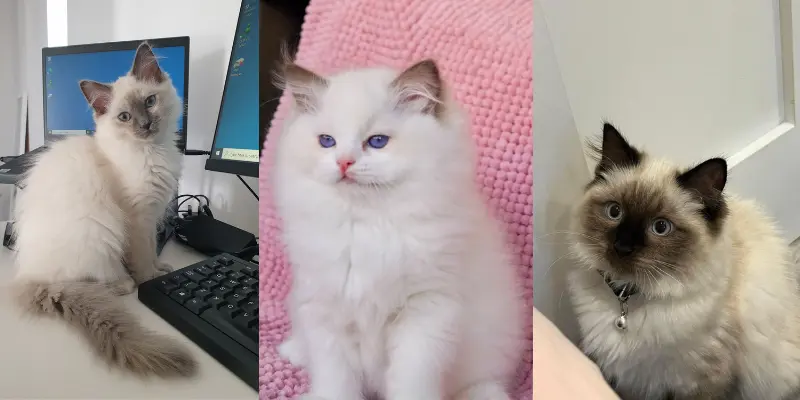
Why These Comparisons Matter
Understanding the differences between lilac, blue, chocolate and seal makes it much easier for cat parents to recognize what color their Ragdoll truly is. It also helps explain why lilac is so rare because it sits at the lightest, most diluted end of the Ragdoll color spectrum.
Whenever we gather photos of our Ragdolls in different colors, the lilac always catches our eye. There’s just something about that powdery pastel shade that shines like a little jewel among the richer and darker tones.
Fun Facts & Myths About the Lilac Ragdoll Cat Color
Every Ragdoll color has its own charm but lilacs come with a touch of mystery. Because they are so rare and pastel in tone and many cat lovers are curious about them. Let’s share some fun tidbits and bust a few myths!
Fun Facts
- Not really purple: Despite the name, lilac Ragdolls aren’t actually purple. The word “lilac” in cat colors means a diluted version of chocolate with a pinkish gray tone.
- Slow to bloom: Lilac kittens often take longer to show their true colors and watching their coat develop is like seeing a painting slowly come to life.
- Pastel perfection: Among all Ragdoll colors, lilacs are the lightest and most delicate shade. Their soft coloring makes them look extra angelic in photos.
- Rare treasures: Lilacs are considered one of the rarest Ragdoll variations which is why meeting one feels extra special.
Myths
- Myth 1: Lilac Ragdolls are a different breed.
✘ False! Lilac is simply a color variation of the Ragdoll breed, not a separate breed. - Myth 2: Their color makes them behave differently.
✘ Not true. All Ragdolls like seal, blue, chocolate, flame or lilac share the same sweet, floppy and cuddly personality. - Myth 3: Lilac cats stay white forever.
✘ Nope! While they are born white their lilac points slowly appear and deepen as they grow into adults.
Why We Love These Fun Details
Living with a lilac Ragdoll feels a bit like having a secret treasure that not everyone gets to see. We love sharing these little facts with friends who are curious about why our kitty looks so different. And let’s be honest, clearing up the myths always makes us smile.
Conclusion
The Lilac Ragdoll Cat truly feels like a touch of magic wrapped in silky fur. From their frosty white bodies to their delicate pastel points and those unforgettable blue eyes, everything about them is gentle, rare and enchanting. They may be one of the rarest Ragdoll colors but that only makes sharing life with them feel even more special.
We feel so lucky every day to have our lilac cuddle buddy by our side. Their beauty is breathtaking but what really melts our hearts is how their sweet and floppy Ragdoll personality shines through, proving that no matter the color, the love they give is endless.
Do you have a lilac fluffball of your own? We’d love to hear your stories, see your photos and share in the joy of these pastel beauties. Drop us a comment or send us a message and let’s celebrate our lilac treasures together!
Related FAQ Talk
Here are frequently asked questions:
Yes! Lilac Ragdolls are one of the rarest Ragdoll colors because they require a very specific combination of genes. That’s why meeting one feels like finding a hidden treasure.
Often, yes. Because lilacs are less common, breeders may ask a higher price. But remember, health and temperament are always more important than coat color when choosing a kitten.
Lilac Ragdolls have pinkish gray points that look pastel and powdery. Blue Ragdolls on the other hand have darker and steel gray points with a cooler tone. Comparing them side by side usually makes the difference clear.
Nope! All Ragdolls, no matter their color, share the same gentle, floppy and loving personality. Lilacs may look unique but their hearts are just as sweet as any other Ragdoll’s.
You will start to see lilac points appear around 8–12 weeks but it can take up to 2–3 years for their coat to fully mature into its true pastel shade. Patience is the key and it’s worth the wait!
Yes. Lilac is an officially recognized Ragdoll color by most major cat associations including TICA and CFA, making them just as “official” as seal, blue or chocolate Ragdolls.

- Be Respectful
- Stay Relevant
- Stay Positive
- True Feedback
- Encourage Discussion
- Avoid Spamming
- No Fake News
- Don't Copy-Paste
- No Personal Attacks



- Be Respectful
- Stay Relevant
- Stay Positive
- True Feedback
- Encourage Discussion
- Avoid Spamming
- No Fake News
- Don't Copy-Paste
- No Personal Attacks


